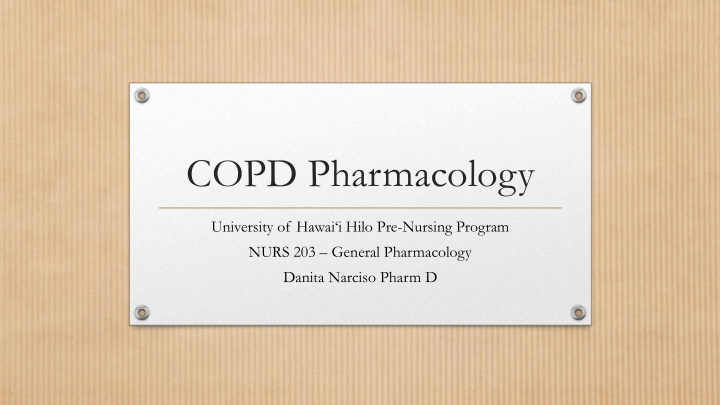



COPD Pharmacology University of Hawai‘i Hilo Pre -Nursing Program NURS 203 – General Pharmacology Danita Narciso Pharm D
Objectives • Understand the epidemiology and pathophysiology of COPD • Understand the pharmacologic reasoning behind first choice medications for COPD vs asthma • Know the general pharmacologic characteristics of medications used to treat COPD
Definition Small airways disease • Airway inflammation • Airway fibrosis/luminal plugs “Chronic Obstructive Pulmonary Disease • Increased airway resistance (COPD), a common preventable and treatable disease, is characterized by persistent airflow limitation that is usually progressive and associated with an enhanced chronic inflammatory response in AIRFLOW LIMITATION the airways and the lung to noxious particles or gases. Exacerbations and comorbidities contribute to the overall severity in individual patients.” Parenchymal destruction -The GOLD Report • Loss of alveolar attachments • Decrease in elastic recoil
Epidemiology and Etiology • Epidemiology • Etiology • Difficult to determine • Smoking • • Pollution Leading cause of morbidity and mortality worldwide • Occupational exposures • 4 th leading cause of death in U.S. • Age • Lack of standardization • Alpha 1-antitrypsin deficiency • Under diagnosed • Airway hyper-responsiveness • Under reported • Lung growth and development
Additional risk factors • Socioeconomic status • Poverty - Exposures, pollution, crowding, poor nutrition, infections, or other • Asthma/bronchial hyper-reactivity • Asthmatics at higher risk of contracting COPD after adjusting for smoking (12 fold) • Asthmatics more likely to present with irreversible airflow limitation • BHR second only to smoking in COPD risk factors • Excess loss in FEV1 • Smoking vs asthmatics – similar reduced lung function • Chronic bronchitis • May or may not be associated with lung function decline • Smokers with CB are even more likely to contract COPD • Infections • Exacerbations & Development
Symptoms of COPD • Defining symptoms • Chronic and progressive cough • Dyspnea • Sputum production • Some patients may experience other non-specific symptoms • Wheezing • Chest tightness • Weight loss • Fatigue • Anxiety and depression
Pathophysiology • Changes in tissue • Airways • Parenchyma • Pulmonary vasculature • Airway remodeling • Repeated injury and repair • Idiopathic inflammation in non- exposed patients
Airflow limitation and air trapping • Airflow limitation • Air trapping • Caused by • Decrease in ability to inspire created by hyperinflation due to air trapped in the • Inflammation lungs • Fibrosis • Leads to • Mucus secretion • Decrease in functional residual capacity • SOB • Reduced by the use of bronchodilators
Gas exchange & mucus hyper-secretion • Gas exchange • Mucus hyper-secretion • Reduction in gas exchange • Mucus producing goblet cells • • Produces Increased number • Hypoxemia • Increased size • Hypercapnia
Stable/Chronic COPD – Short-acting bronchodilators Beta 2 -agonists Anticholinergics • Ipratropium bromide, oxitropium bromide • Fenoterol, Levalbuterol, Albuterol, terbutaline • MDI • MDI, DPI, nebulizer solution, oral, & injection • Onset 15-20 mins & effects may last up to 9 • Rapid onset (5 mins) of effects & wears off in 4- hours 6 hours • ADR’s • ADR’s – • Dry mouth, bitter (metallic) taste, nausea • Tachycardia, arrhythmia, tremor, hypokalemia
Stable/Chronic COPD – Long-acting bronchodilators Long acting Beta2 agonists (LABA) Long-acting Anticholinergics • Salmeterol, formorterol, arformorterol, • Tiotropium, a clidinium, glycopyrronium, indacaterol, tolobuterol, vilanterol umeclidinium • Dry powder inhalers, MDI, transdermal, • Inhaled dry powder inhaler (Handihaler with capsules), SMI and nebulizer solutions • Onset 30 mins, duration 12 to greater than 24 • Dosed Q12 hrs or Q24 hrs hours • ADRs • Dosed daily • Headache, neuromuscular and skeletal • ADRs pain, HTN, dizziness, rash • Dry mouth, constipation, urinary retention, tachycardia, blurred vision, glaucoma
Stable/Chronic COPD – Short-acting & Long- acting bronchodilators • Improve FEV 1 , improve emptying of lungs, reduce hyperinflation at rest and during exercise • May be given scheduled or as needed • Drug selection may determined by comorbid conditions, individual patient response, side effects, or convenience/cost • Inhaled preferred over oral • Recommended in all COPD patient groups • Combinations provide better efficacy when used in patients with no symptom improvements on monotherapies
Stable/Chronic COPD - Methylxanthines • Theophylline and aminophylline • Due to low efficacy and low tolerability, generally no longer recommended – used for patients who or are not able to coordinate inhaled therapy or the unavailability / affordability of inhaled therapy • Oral and parenteral • 200 mg BID, titrated to target dose every 3-5 days to achieve 8-15 mcg/ml • Requires serum concentrations 1-2 times per year once steady state is achieved • Toxicity may be seen in therapeutic ranges • Factors that decrease clearance – age, pneumonia, liver dysfunction, ventricular failure, drugs (cimetidine, macrolide abx, & fluoroquinolone abx) • ADRs • Gastrointestinal – dyspepsia, nausea, vomiting, diarrhea • Cardiovascular - tachycardia • CNS – headache and dizziness
Stable/Chronic COPD – PDE-4 inhibitors • Roflumilast – Reduce inflammation, no direct bronchodilator effects, but lowers FEV 1 when combined with other medications and should always be used with a long-acting bronchodilator • Oral (pill) • Q 24 hour dosing • ADR’s • Nausea, reduced appetite, abdominal pain, diarrhea, weight loss and headache • Do not use with theophylline
Stable/Chronic COPD - Corticosteroids Inhaled Oral • Beclomethasone, budesonide, fluticasone • Prednisone & methyl-prednisolone • Recommended in severe or very severe • Oral (pill) COPD in combination with long-acting bronchodilator(s) alone or with PDE4 • Not recommended in the treatment inhibitors of chronic stable COPD • DPI, MDI, & solution for nebulizer • Improved symptoms and quality of life • ADRs • Locally – well tolerated (hoarseness, sore throat, candidiasis), may increase risk of pneumonia and fracture
COPD - Exacerbation • Definition • “an acute event characterized by a worsening of the patient’s respiratory symptoms that is beyond normal day-to- day variations leads to a change in medication” • Differentiation between daily variations and exacerbation is important • Prognosis is poor • 5 year mortality rate of 50% • Successful prevention • Understand how to use medications
Questions
Recommend
More recommend